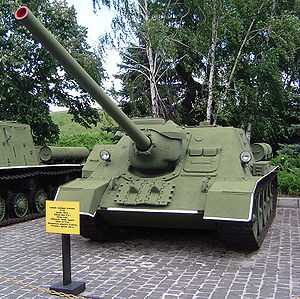SU-100
| |||||||||||||||||||||||||||||||||||||||||||||||||
The SU-100 was a Soviet casemate-style tank destroyer armed with a powerful[1] 100 mm anti-tank gun. It was used extensively during the last year of World War II and saw service for many years afterwards with the armies of Soviet allies around the world.[1]
Development
The SU-85 was developed from the same chassis as the T-34 tank, but replaced its turret with a casement installation allowing larger guns to be fitted. This was used with the 85 mm D-5 gun, providing dramatically upgraded firepower compared to the T-34's 76.2 mm models. Introduced to service in 1943, the SU-85 was quickly rendered obsolete when designers managed to mount the same gun on the T-34-85.[1]
This led to efforts to up-gun the SU-85 as quickly as possible. Development was conducted under supervision of L. I. Gorlitskiy, chief designer of all medium Soviet self-propelled guns. The work started in February 1944 and first prototype of SU-100, called "Object 138", was built in March. After intensive testing with different models of 100 mm gun Soviet engineers approved the D-10S gun for mass production.[1] This gun was developed in Constructors Bureau of Artillery Factory No. 9 under guidance of F. F. Petrov. After the Second World War this gun was installed on T-54 and T-55 tanks and its derivatives were in service forty years after initial development.
It was built at the UZTM (Russian abbreviature УЗТМ for Уральский Завод Тяжелого Машиностроения – Ural Heavy Machinery Factory, also called Uralmash) in Yekaterinburg. The SU-100 quickly proved itself to be able to penetrate around 125 mm (4.9 in) of vertical armor from a range of 2,000 m (1.2 mi) and the sloped 80 mm (3.1 in) front armor of the German Panther from 1,500 m (0.93 mi).[1]
The hull of SU-100 had major improvements over the SU-85; the thickness of the front armour was increased from 45 to 75 mm (1.8 to 3.0 in), and the commander's workplace was made in a small sponson on the right side of the hull; combined with the commander's cupola this improved the commander's effectiveness. For better ventilation two ventilator units were installed, instead of only one as in the SU-85. Mass production began in September 1944.
Service history


The SU-100 saw extensive service during the last year of the war. It was used en masse in Hungary in March 1945, when Soviet forces defeated the German Operation Frühlingserwachen offensive at Lake Balaton.[1] By July 1945, 2,335 SU-100s had been built.
The vehicle remained in service with the Red Army well after the war; production continued in the Soviet Union until 1947 and into the 1950s in Czechoslovakia. It was withdrawn from Soviet service in 1957 but many vehicles were transferred to reserve stocks. Some exist to this day in the Russian Army holding facilities.
Many Warsaw Pact countries also used the SU-100, as did Soviet allies such as Egypt, Angola and Cuba. A few SU-100 were delivered to Yugoslavia after the war, under the designation M-44.[2] The SU-100 saw service in the fighting that accompanied the 1956 Suez Crisis, in which the Egyptians used SU-100s against Israel's M4 Sherman tanks. The vehicle was also utilized in the 1967 Six-Day War and the 1973 Yom Kippur War. It was modified slightly to adapt it to the sandy conditions of the Middle East, thus creating the SU-100M variant. Exported SU-100s continued in service until the 1970s, and in some countries, even later. Yugoslavs used them during the civil war however due to lack of spare parts they were quickly retired, but performed satisfactorily. The SU-100 remains in use by the Vietnam People's Army and the Korean People's Army Ground Force despite the age of the design.
SU-100s entered service with the People's Liberation Army (PLA) of China after 1 December 1950 when Soviet forces left Dalian. The armaments in Dalian were sold to China, including 99 SU-100s, 18 IS-2 heavy tanks, and 224 T-34s, with which PLA formed its 1st Mechanised Division.
In popular culture
The crew of a World War II SU-100 and their vehicle are the heroes of the old Soviet film «На войне как на войне» Na vojne kak na vojne ("At War as at War", literally: "In wartime it's like wartime"), one of several Soviet films made about self-propelled artillery men. Veterans of the German-Soviet War found this picture quite realistic. The movie includes a Soviet tankmen song, which is popular with both Russian armoured soldiers and civilians.

A SU-100 is used by the protagonists in the movie The Misfit Brigade, where it is portrayed as a German tank, because it was readily available in Yugoslavia (where the movie was shot) and for its passable resemblance to German turretless assault guns and tank destroyers. Ironically, the film has a scene where the Germans spot one, supposedly captured by the Russians, and proclaim: "That's one of ours! It sure is, and it's a terrible paint job. You can still see the cross! ... Ivan's pinched my tank!" The film is also known as Wheels of Terror, based on the book by Sven Hassel.
See also
- List of Soviet tanks
- Jagdpanther
References
External links
| Wikimedia Commons has media related to SU-100. |
- The SU-100 Tank Destroyer at Battlefield.ru
- SU-100 at WWIIvehicles.com
- SU-100 data at OnWar.com
| ||||||||||||||||||||||||||||||||||||||||||||||||||||||||||||||||||||||||||||||||||||||||||||
